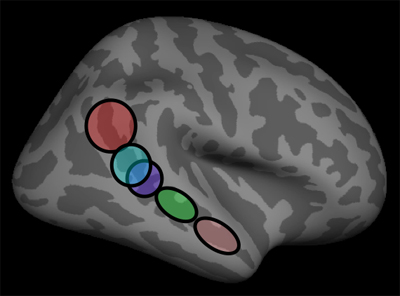Unit Overview
 | fMRI studies conducted by Nancy Kanwisher, Rebecca Saxe, and colleagues reveals subregions of area STS in the human brain, roughly portrayed here, that are engaged in aspects of social cognition such as Theory of Mind, voice perception, language, and face analysis. (Image courtesy of Nancy Kanwisher, used with permission.) |
Social cognition is at the core of human intelligence. Social interactions are the source of much of human knowledge and a large part of everyday human activity. Social behavior also engages a large part of the neural circuitry in the brain and has driven the evolution of the human brain beyond its primate origins. In this unit, you will learn about the neural and perceptual basis of social cognition, and powerful quantitative methods for analyzing fMRI data to probe the neural mechanisms underlying tasks such as inferring the mental states of others.
Nancy Kanwisher touches upon research at the Center for Brains, Minds, and Machines that explores central aspects of social intelligence, such as the recognition of faces, emotions and direction of gaze; use of subtle body cues to predict an agent's actions; and identification of specialized brain regions for social cognition.
Ken Nakayama first draws parallels between social behavior in humans and animals, and then explores in depth, the ability of humans to recognize faces and to rapidly exploit subtle visual cues to predict the actions of other agents.
In Part 1 of Rebecca Saxe's lecture, you will learn how fMRI studies led to the discovery of a brain region that is selectively engaged in tasks that elicit thoughts about the mental states of others, so-called Theory of Mind. You will also learn about correlation based methods for analyzing fMRI data.
The second part of Rebecca Saxe's lecture shows how recent advances in fMRI analysis methods, such as Multivariate Pattern Analysis (MVPA), may provide a more detailed picture of how the brain encodes high-level cognitive information.
Unit Activities
Useful Background
- Introductions to neuroscience and cognitive science
- Background on the sociality of primates and its connection to intelligence, from Winrich Freiwald's Lecture L1.5 in Unit 1: Neural Circuits of Intelligence.
- An introduction to machine learning is useful for Part 2 of Rebecca Saxe's lecture. View Tutorial T3.1 Machine Learning (Part1) by Lorenzo Rosasco.
Videos and Slides
Further Study
Additional information about the speakers' research and publications can be found at their websites:
Deen, B., K. Koldewyn, et al. "Functional Organization of Social Perception and Cognition in the Superior Temporal Sulcus." Cerebral Cortex 25, no. 11 (2015): 4596–4609.
Duchaine, B., and K. Nakayama. "The Cambridge Face Memory Test: Results for Neurologically Intact Individuals and an Investigation of its Validity Using Inverted Face Stimuli and Prosopagnosic Participants." Neuropsychologia 44, no. 4 (2006): 576–85.
Koster-Hale, J., and R. Saxe.  "Theory of Mind: A Neural Prediction Problem." (PDF) Neuron 79 (2013): 836–48.
"Theory of Mind: A Neural Prediction Problem." (PDF) Neuron 79 (2013): 836–48.
Koster-Hale, J., M. Bedny, et al.  "Thinking About Seeing: Perceptual Sources of Knowledge are Encoded in the Theory of Mind Brain Regions of Sighted and Blind Adults." (PDF - 1.2MB) Cognition 133 (2014): 65–78.
"Thinking About Seeing: Perceptual Sources of Knowledge are Encoded in the Theory of Mind Brain Regions of Sighted and Blind Adults." (PDF - 1.2MB) Cognition 133 (2014): 65–78.
Peterson, M. F., J. Lin, et al.  "Individual Differences in Face Looking Behavior Generalize from the Lab to the World." (PDF - 62.7MB) Journal of Vision 16, no. 7 (2016): 1–18.
"Individual Differences in Face Looking Behavior Generalize from the Lab to the World." (PDF - 62.7MB) Journal of Vision 16, no. 7 (2016): 1–18.
Skerry, A. E., and R. Saxe.  "Neural Representations of Emotion are Organized Around Abstract Event Features." (PDF - 2.1MB) Current Biology 15 (2015): 1–10.
"Neural Representations of Emotion are Organized Around Abstract Event Features." (PDF - 2.1MB) Current Biology 15 (2015): 1–10.
Vaziri-Pashkam, M., S. Cormiea, et al.  "Predicting Actions Before They Occur." (PDF - 1.4MB) Center for Brains, Minds & Machines, Memo No. 038 (2015).
"Predicting Actions Before They Occur." (PDF - 1.4MB) Center for Brains, Minds & Machines, Memo No. 038 (2015).

 Subscribe to this collection
Subscribe to this collection


